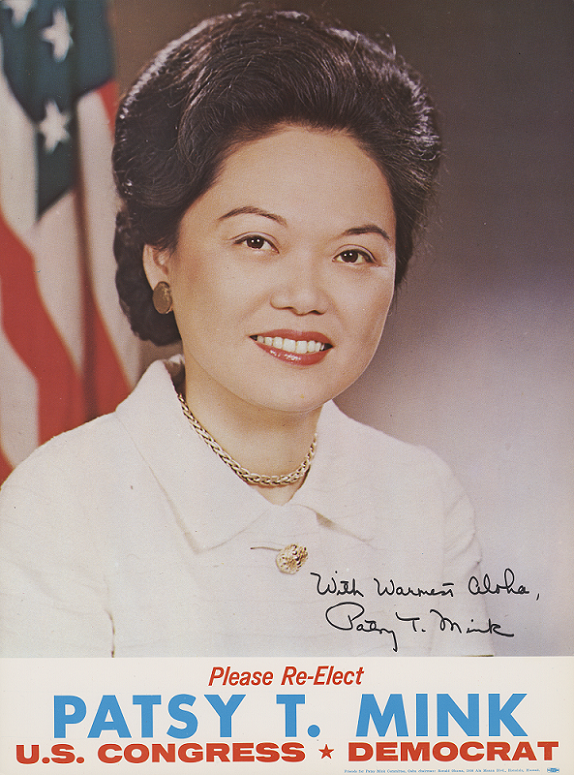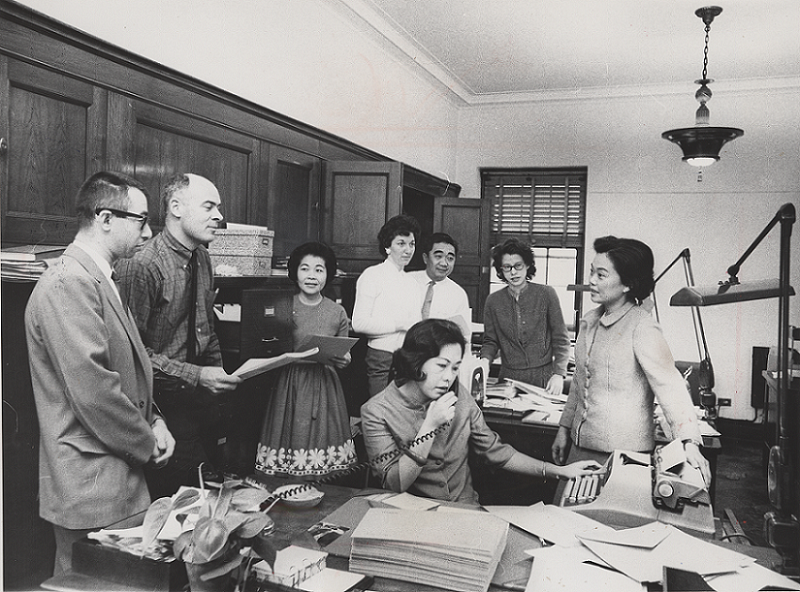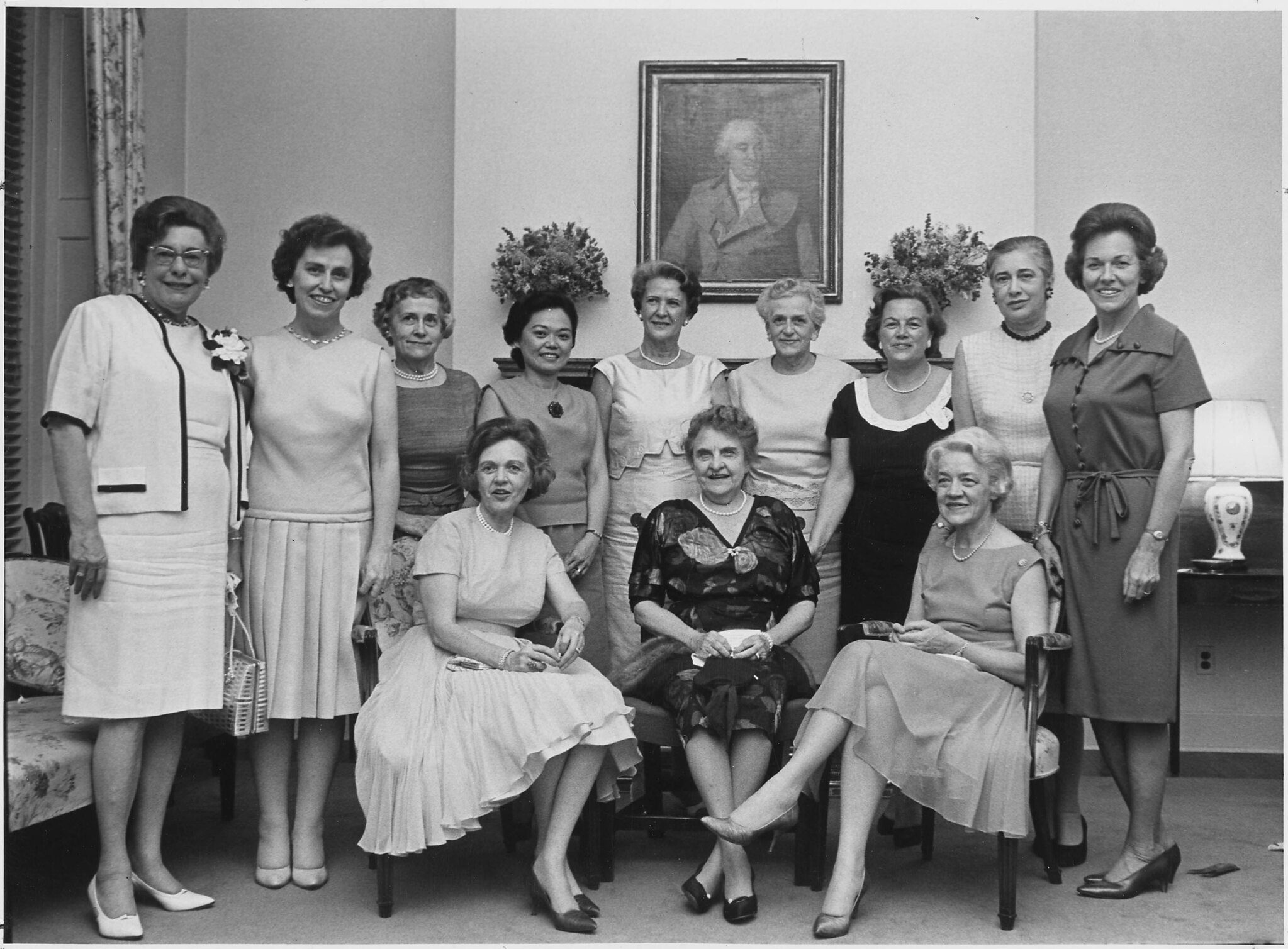This video was created by the New-York Historical Society Teen Leaders in collaboration with the Untold project.
Patsy Takemoto was born on the island of Maui in the territory of Hawaii in 1927. Patsy was a Sansei Japanese American. This meant her parents were born in Hawaii, and her grandparents were immigrants from Japan.
Patsy was fortunate to have a middle-class upbringing in a predominantly working-class community. While many of her neighbors and peers worked on sugar plantations, Patsy went to school. She graduated from high school in 1944 as valedictorian and president of her class.
Patsy enrolled in the University of Hawaii as a pre-med student. After a year, she decided to attend school in Nebraska. As a student at the University of Nebraska, she was required to live in a segregated dorm designated for international students and students of color. Patsy strongly objected to this racist policy and campaigned to change it. She recruited the support of students, alumni, teachers, parents, and local community members. Within a year, the University of Nebraska ended its segregation policies.
After graduating from college, Patsy applied to more than ten medical schools across the United States. All of them turned her down because she was a woman. After facing such glaring sexism, Patsy was disappointed and angered. She had dreamed of becoming a doctor since she was a little girl. Patsy then decided to change directions and applied to law school. She was invited to study law at the University of Chicago. She was one of only two women in her class.
While studying law, Patsy met fellow graduate student and geologist John Mink. John and Patsy married in 1951 and moved to Hawaii after completing their studies. They had one daughter named Gwendolyn.
Patsy passed the Hawaii bar exam in 1953, but no law firm would hire her. She was turned down for being a woman and mother and, because John was white, for being in an interracial marriage. Eventually, Patsy opened her own practice. She took cases that larger firms often turned down, including divorces, adoptions, and other family and women-focused issues.
I didn’t start off wanting to be in politics. Not being able to get a job from anybody changed things.
Around the same time, Patsy became involved in the Democratic Party of Hawaii. Her efforts to recruit and register young voters contributed to Hawaii’s “Revolution of 1954.” In that year, the Democratic Party overthrew the Republican Party’s long-standing control of the territory’s House of Representatives and Senate. The success of the “revolution” was built on the efforts of Japanese-American veterans who were tired of being treated as inferior.
In 1956, Patsy ran for Hawaii’s House of Representatives. Democratic Party leaders discouraged her from running because they did not believe a Japanese-American woman could win. Patsy refused to accept this. She walked almost the entire length of her district, knocking on doors and speaking to community members one at a time. Her personal commitment paid off, and she won. Two years later, she once again dismissed party leaders’ recommendations and was successfully elected to the Hawaiian territory’s Senate.
In 1959, Hawaii finally became the 50th state of the United States. Patsy campaigned to represent Hawaii in Congress but lost. In 1964, she ran again and won. She was the first woman of color to be elected to the United States Congress. Patsy served six consecutive terms in the House of Representatives. She quickly became a champion of gender equality, civil rights, and education.
In 1970, President Richard Nixon nominated Judge George Carswell to fill a vacant seat on the U.S. Supreme Court. Judge Carswell had a reputation for denying equal rights to women and people of color. During the nomination hearings, Patsy said Judge Carswell’s nomination was “an affront to the women of America.” Her testimony helped persuade the Senate to reject his nomination. Instead, Judge Harry Blackmun was appointed to the Supreme Court. Three years later, he wrote the majority opinion extending abortion rights in the famous case Roe v. Wade.
Patsy is most famous for serving as the primary author of Title IX. Title IX prohibits gender discrimination in any educational institution that receives funding from the federal government. Title IX successfully passed in 1972. It dramatically changed women’s and girls’ access to education, including school-sponsored sports.
Not all of Patsy’s ideas were successful, but that did not stop her from trying. She believed that in order to change the world, a person had to stand up against the majority. Patsy fought for bilingual education, affordable student loans, free childcare, and an end to the Vietnam War.
In 1977, Patsy ran for Senate and lost. President Jimmy Carter appointed her Assistant Secretary of State for Oceans and International Environmental and Scientific Affairs. She served in that position for two years before returning to Honolulu.
Patsy stayed involved in politics by serving on Honolulu’s city council and working as a lawyer. In 1990, she returned to the House of Representatives and held the office for the rest of her life.
Patsy died from pneumonia on September 28, 2002. Congress renamed Title IX the Patsy T. Mink Equal Opportunity in Education Act. At the time of her death, she was running for reelection. Constituents honored her memory by posthumously re-electing her in a landslide.
Vocabulary
- bar: A collection of professional lawyers certified to practice in a given region.
- Bureau of Oceans and International Environmental and Scientific Affairs: A division of the federal government that protects American international interests in oceans and areas of the environment, science, and health.
- interracial: Involving two or more races.
- Nisei: First-generation Japanese Americans who were born in the United States to Japanese-born parents.
- posthumously: After death.
- Sansei: Second-generation Japanese Americans whose grandparents were immigrants to the United States.
- segregated: Separated by race, ethnicity, gender, or other identifying quality.
- Roe v. Wade: A 1973 Supreme Court case that ruled women had the right to legal and safe abortions.
- Title IX: A 1972 civil rights law banning all gender discrimination from educational institutions that receive federal funding. Renamed the Patsy T. Mink Equal Opportunity in Education Act in 2002.
Discussion Questions
- How did Patsy’s experiences as a student and lawyer shape her political career?
- Patsy was particularly passionate about Title IX and equal access to education. Why do you think this issue mattered to her so much?
- Patsy often supported unpopular progressive ideas in Congress. What does this tell you about her character?
- Patsy Mink served in Congress for nearly 24 years. Why do you think she was such an effective and successful legislator?
Suggested Activities
- AP Government Connections:
- 2.1: Congress: The House of Representatives and the Senate
- 2.2: Structures, powers and function of Congress
- 2.3: Congressional Behavior
- 4.1: American Attitude About Government and Politics
- 4.3: Changes in Ideology
- 4.4: Influence of Political Events on Ideology
- 4.8: Ideology & Policy-making
- 4.10: Ideology & Social Policy
- 5.9: Congressional Elections
- 5.10: Modern Campaigns
- Invite students to conduct a close study of the three images related to this life story. How does each add to their understanding of Patsy’s life and career? Which images stands out most to students?
- Read Patsy’s life story in conjunction with the life stories of Bella Abzug and Helen Gahagan Douglas. How did each congresswoman approach her political career to bring about change?
- Title IX is most famous for expanding the realm of women’s sports in schools and beyond. Connect Patsy’s life story to that of Billie Jean King and consider how both leaders shaped the world of women’s sports.
- Bella Abzug, Gloria Steinem, Betty Friedan, Shirley Chisholm, and Patsy Mink were founders of the National Political Women’s Caucus. Review their respective resources in WAMS and encourage students to think about what each woman brought to this organization and their motivations for participating.
Themes
AMERICAN IDENTITY AND CITIZENSHIP; POWER AND POLITICS; ACTIVISM AND SOCIAL CHANGE









